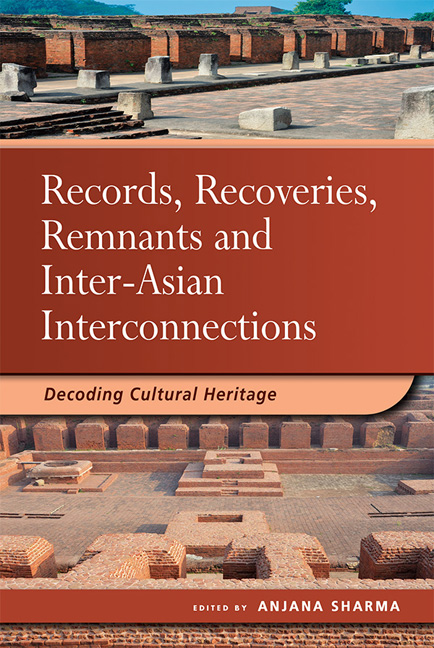Book contents
- Frontmatter
- Dedication
- Contents
- Contributors
- Acknowledgements
- 1 Introduction: Records, Recoveries, Remnants and Inter-Asian Interconnections — Decoding Cultural Heritage
- 2 Negotiating Place and Heritage: Creating Nalanda University
- 3 India, Magadha, Nalanda: Ecology and a Premodern World System
- 4 Collecting the Region: Configuring Bihar in the Space of Museums
- 5 Heritage Preservation in the Gaya Region
- 6 Setting the “Records” Straight: Textual Sources on Nālandā and Their Historical Value
- 7 “Central India Is What Is Called the Middle Kingdom”
- 8 The Object | The Tree: Emissaries of Buddhist Ground
- 9 Tracing Transregional Networks and Connections Across the Indic Manuscript Cultures of Nusantara (AD 1400–1600)
- 10 Seeking a Sufi Heritage in the Deccan
- 11 Archaeological Remains at Nalanda: A Spatial Comparison of Nineteenth Century Observations and the Protected World Heritage Site
- 12 A Heritage Gem Sits in the Heart of a City, Unacknowledged, Incognito: The Case for Recognizing Kolkata Chinatown as a Historic Urban Landscape
- Index
- Miscellaneous Endmatter
6 - Setting the “Records” Straight: Textual Sources on Nālandā and Their Historical Value
Published online by Cambridge University Press: 04 July 2018
- Frontmatter
- Dedication
- Contents
- Contributors
- Acknowledgements
- 1 Introduction: Records, Recoveries, Remnants and Inter-Asian Interconnections — Decoding Cultural Heritage
- 2 Negotiating Place and Heritage: Creating Nalanda University
- 3 India, Magadha, Nalanda: Ecology and a Premodern World System
- 4 Collecting the Region: Configuring Bihar in the Space of Museums
- 5 Heritage Preservation in the Gaya Region
- 6 Setting the “Records” Straight: Textual Sources on Nālandā and Their Historical Value
- 7 “Central India Is What Is Called the Middle Kingdom”
- 8 The Object | The Tree: Emissaries of Buddhist Ground
- 9 Tracing Transregional Networks and Connections Across the Indic Manuscript Cultures of Nusantara (AD 1400–1600)
- 10 Seeking a Sufi Heritage in the Deccan
- 11 Archaeological Remains at Nalanda: A Spatial Comparison of Nineteenth Century Observations and the Protected World Heritage Site
- 12 A Heritage Gem Sits in the Heart of a City, Unacknowledged, Incognito: The Case for Recognizing Kolkata Chinatown as a Historic Urban Landscape
- Index
- Miscellaneous Endmatter
Summary
INTRODUCTION
Since its inscription into the UNESCO's list of world heritage sites in July 2016 the ruins of Nālandā will certainly attract more attention through the Indian and global public than hitherto. The most recent or forthcoming publications on Nālandā by Frederick Asher and Mary Stewart critically assess the archaeological and art-historical evidence, and for this purpose they constantly refer to textual sources. These references are made on the basis of the old nineteenh century translations of the most extensive texts on Nālandā, the Chinese records, and of the Middle-Indic (Pāli, Prākṛt) and Tibetan sources. It seems therefore appropriate that a volume on Nālandā also contains a contribution from the textual-philological point of view, not only, as the title implies, to set the records straight, but also to give contextually informed translations and discussions of the relevant textual sources. I do not claim at all that these are the final words on all the issues addressed here, but would rather like to open a critical discourse on and about some of these sources.
The textual sources referring to Nālandā are threefold: inscriptions, Buddhist and Jain “canonical” texts in Indic languages, and passages in and from the travelogues of Chinese visitors or residents of the monastery and relatively late Tibetan historiographical writings. Among these sources the ones deemed to be most informative and reliable are the Chinese records of Xuanzang (600/602–664), of his biographer(s), and of Yijing (635–713), because both monks resided and studied in Nālandā for several years. Information extracted from these sources, digested mostly from the nineteenth century translations by Beal and others, feed rather uncritically into the major historical narrative of the monastery, pushing its existence even back to the time of the Buddha. The article has a focus on the Chinese texts and their translations and the Pāli and Jain sources while neglecting other sources like inscriptions. As a natural consequence of this, I will not discuss the paraṃparā of kings given by Xuanzang, since relation cannot be done without the evidence from royal inscriptions and other historical sources, as important as this is for the reconstruction of the history of the monastery. Due to restriction of space such an analysis has to be given at another occasion.
- Type
- Chapter
- Information
- Records, Recoveries, Remnants and Inter-Asian InterconnectionsDecoding Cultural Heritage, pp. 105 - 140Publisher: ISEAS–Yusof Ishak InstitutePrint publication year: 2018



